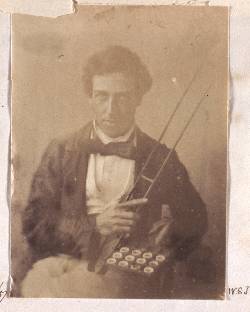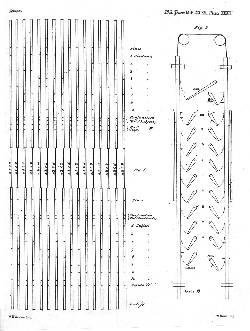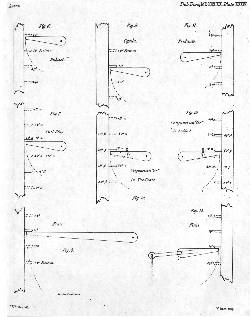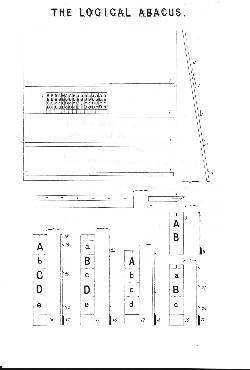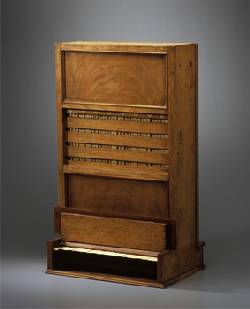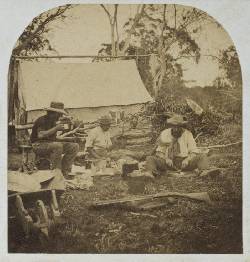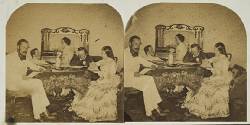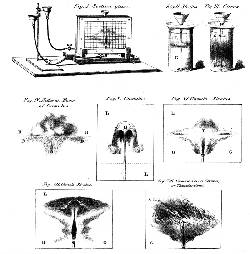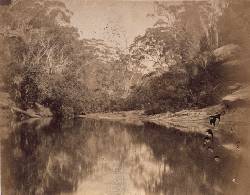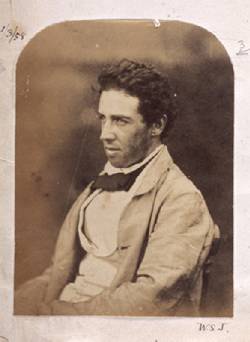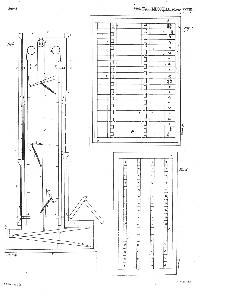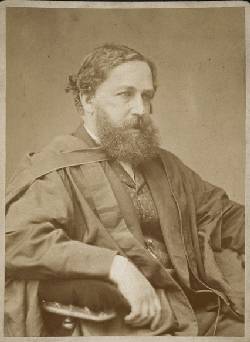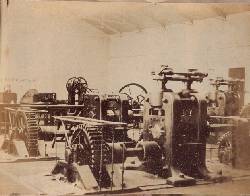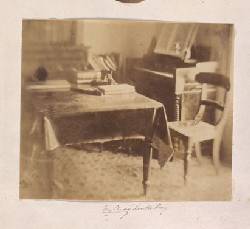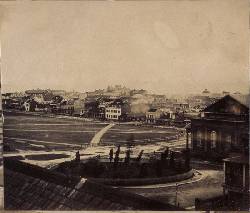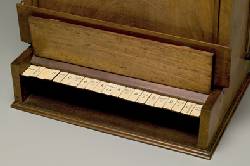Jevons and the Logic ‘Piano’
Lindsay Barrett and Matthew Connell
William Stanley Jevons in Sydney
In October 1854 William Stanley Jevons arrived in Sydney from London. One hundred and fifty years later, on October 28, 2004, Sydney’s Powerhouse Museum opened an exhibition on Jevons’ life and work in Australia.
William Stanley Jevons was born in Liverpool, in England. He studied chemistry in London, and then traveled to New South Wales at the age of 19 to work as an assayer at the Sydney Mint. The Gold Rush was transforming the colony, and his job was to assess the quality and purity of the precious metal pouring into Sydney from the diggings further west. This work put him in a unique position, at the intersection of geology, chemistry, economics and industry.
Wanting to document as many aspects of life in Australia as he could, Jevons also took up photography, producing a comprehensive photographic record of the physical and urban landscape of Sydney. He even took his camera equipment to the goldfields. After five years in Australia Jevons returned to England to continue his formal education and eventually obtained a position teaching economics—a subject he’d studied in detail whilst in Sydney—at Owens College in Manchester. Later he became Professor of Economics at University College, London.
The Powerhouse Museum’s Jevons exhibition includes a substantial collection of his photographs, most of which have never previously been shown. This collection, produced at a time when photography was in its infancy, includes extensive views of Sydney, the Macquarie Street Mint, Middle Harbour, Double Bay and Bondi, the goldfields near Braidwood, as well as some of the earliest interior photographs of work practice and domestic life taken in Australia.
While in Sydney Jevons kept a detailed journal and diaries, and sent regular letters to members of his family describing the environment, his activities, his ideas, and innermost thoughts. Indeed, his time in Sydney had a great influence on his thinking, and played a key role in bringing his ideas to fruition. In fact, Jevons said later that nearly all his principal concepts came to him during this period. The developing colonial city certainly gave him the time, the money and the intellectual freedom to undertake work in a wide range of areas with which he was concerned. While his work at the Mint was important, it left him with both an income and much free time to spend on his various pursuits, and so he found himself a young man in a young city, free of many of the intellectual and social constraints of the Old World.
Using his own words, drawn in particular from his letters and diaries, the Exhibition focuses on Jevons’ Sydney years in order to consider how this young man, in this growing colony, came to formulate the initial conceptions of a number of today’s prominent social and scientific discourses, such as economics, statistics, logic and sociology. Essentially, Jevons’ theories about value can be seen as an intellectual reflection of a change in the dominant industrial forms of the nineteenth century, at the point at which the stationary, factory steam engine and factory production were overtaken by mobile technologies of transport and communication, like railways and the telegraph.
In his later years William Stanley Jevons went on to become a major figure, both in Britain and internationally, in the fields of political economy and social reform. While his name is not generally well known today, Jevons is most often credited with being the first theorist to make economics a mathematical discipline, and he is regarded as one of the founders of the form of neo-classical economics that dominates our current economic thinking and political discourse. Additionally, in 1869 he designed and built what is conceivably the world’s first machine for doing logic inference, a machine that anticipated the contemporary computer by 80 years.
Given William Stanley Jevons’ participation in and influence upon fields as diverse as science, photography and urban geography, and particularly as this work was conducted in colonial Sydney, the Powerhouse Museum was ideally placed to mount this exhibition. The Museum collection includes Jevons’ telescope, along with assaying equipment from the Mint and examples of the coins produced, and photographic equipment of the kind used by Jevons and his photography circle. Additionally, the Museum’s Boulton &Watt beam engine and Loco No 1, the first steam train to run in New South Wales, have been incorporated into the exhibition, with Jevons’ story adding further to their interpretation.
The Logic ‘Piano’
Perhaps the most exciting artefact to be included in the exhibition is Jevons’ original logic machine, or ‘Logic Piano’. With this device—on loan from the Museum of the History of Science at Oxford—the Exhibition provides a rare opportunity for Australian audiences to view this extraordinary 19th century proto-computer. The Powerhouse Museum also owns and displays a fragment of Charles Babbage’s Difference Engine, and together, the two exhibits form an extraordinary sample of the prehistory, or perhaps early history, of computing.
Jevons role in the development of both symbolic logic and the architecture of modern computing is some ways encapsulated in a passage from his diary in 1860:
As I awoke in the morning the sun was shining brightly into my room, there was a consciousness on my mind that I was the discoverer of the true logic of the future I felt a delight such as one can seldom hope to feel. I remembered only too soon though how unworthy and weak an instrument I was for accomplishing so great a work and how hardly I could expect to do it.1
As Jevons intellectual biographer Margaret Schabas points out, the middle of the nineteenth century saw a revival in Britain in the study of logic, with John Herschel, William Whewell and John Stuart Mill approaching Inductive Logic, and Augustus DeMorgan and George Boole establishing the new discipline of Symbolic logic.2 Boole’s 1847 Mathematical Analysis of Logic, and 1854 work An Investigation of the Laws of Thought, became the key texts in the later field.
Busy with all his other projects, Jevons had little time while in New South Wales for the study of Logic. As he noted:
In Sydney I had by me Whateley’s Logic (Elements of Logic, comprising the substance of the article in the Encyclopaedia Metropolitana) but had never read it, I scarcely knew what logic meant—after a time however I read John Mill’s logic which I perhaps partly understood and yet on the other hand I admired Whewell’s Phil of Inductive Science which now seems nothing but a fog …3
His serious involvement and subsequent passion for Logic came about when, on his return to England, he met up with his former undergraduate teacher of mathematics, Augustus de Morgan, by then well-known as a Logician. As Harro Maas has pointed out, Jevons was subsequently ‘one of the first in Britain to catch on to the importance of the newly developed formal logical systems of Boole and De Morgan.’4
George Boole was unconvinced by Aristotle’s Syllogism. Instead, he sought a general theory of inference. Others, like Gottfried Leibniz, had already tried to seek a common formal structure, but Boole had managed to do so by limiting quantitative algebra to two values.
Jevons believed this to be a very important text, indeed the most important work in logic for centuries, and was scathing about the lack of interest by other logicians. But he also saw problems with it, and by 1961 he was developing his own system of logic based on what he eventually called the ‘Substitution of Similars’, whereby ‘philosophy would be shown to consist solely in pointing out the likeness in things.’5 In 1863 he published his work first work on the subject, Pure Logic, which was hardly a success, with four copies sold in 6 months. But Jevons was a great one for persistence.
In the introduction to Pure Logic, he states:
I have to acknowledge that in a considerable degree t in his admirable and highly original Mathematical Analysis of Logic. The forms of my system may, in fact be reached by divesting his system of a mathematical dress which to say the least is not essential to it. The system being restored to its proper simplicity, it may be inferred, not that the logic is a part of mathematics as is implied in Prof Boole’s writings but that the mathematics are rather derivatives of logic.6
In the book he then outlines a number of aspects proceeding from his notion of the ‘Substitution of Similars’, the basic proposition of which is: for any term occurring in any proposition—substitute the term which is asserted in any premise to be identical with it. So if we take Jevons own somewhat chemically suspect example:
Iron is a metal
Metal is an element
Iron=metal
Metal=element
Therefore
Iron=element
Proceeding in this fashion, one substitutes in the same way as one would in algebra, and Jevons indeed makes this point by consistently using the = sign. Jevons called this ‘direct inference’. But Jevons describes another approach called ‘indirect inference’. This method of indirect inference, the application of operations and the laws governing those operations, is directly deduced from his ‘Substitution of Similars’, and becomes the basis for the mechanical performance of logical inference.
Jevons was quite taken with an example of indirect inference outlined by the Stoic philosopher Chrysippus, and he uses it conclude the first chapter of Pure Logic:
This creature, saith Chrysippus (of the dog) is not void of Logick: for, when in following any beast he cometh to three several ways, he smelleth the one, and then to the second, and if he find that the beast which he pursueth be not fled one of these two ways, he presently without smelling any further to it, taketh the third way; which saith the philosopher, is as if he reasoned thus: the beast must be gone either this, or this, or the other way; but neither this nor this; Ergo the third: so away he runneth.7
Essentially Jevons established an approach to logical inference based on exactly this process of elimination:
Iron is a metal
Metal is an element
Iron is
- Metal, element
- Metal, not element
- Not element, metal
- Not element, not metal
The first premise tells us that iron is metal thus 3 and 4 are excluded
The second premise tell us metal must be element excluding 2
In the same way that Chrysippus’s dog doesn’t need to smell (analyse) the third path but simply proceed down it after eliminating the other two, in the problem above we conclusively realise that the first premise is correct purely on the basis of the elimination of the other three. This is a trivial example but it clearly illustrates Jevons’ general method for what he calls his ‘logical alphabet’.
As early as 1863 Jevons was using a ‘logical slate’ on which he had his combinations typed up ready for elimination. In his later work The Substitution of Similars he describes (in homage to DeMorgan) his logical ababcus: a series of wooden boards with various combinations of true and false terms. It was intended that they be arranged on a rack and a ruler used to remove certain excluded combinations. This was the basic outline of the device that, with the addition of levers and pulleys, Jevons had a Salford clock maker construct for him in 1869. Fitted within a wooden case, and with a keyboard mounted on the front to operate the substitution mechanism, this was his logic ‘piano.’
The Logic Piano can deal with up to 4 terms. Jevons had in fact wanted to build a machine capable of dealing with up to 16 terms, but it would have been too large and taken up a whole wall in his office. The logic expressions are typed (or perhaps played) via the keys, and hitting full stop removes all impossible combinations from the screen. The copula is the equals key, while the ‘finis’ key resets the machine.
Jevons and modern computing
Jevons’ Logic Piano anticipates contemporary computing in an oblique fashion. Computers as we know run on 1 and 0s. Indeed the logical aspect of a computer sits at the bottom of its structure and is embodied in the circuitry (presuming it is electronic of course). Jevons system of logic uses the same basic logic operations, and indeed, in 1940 a young American engineer called Claude Shannon showed in his Masters thesis ‘A symbolic analysis of relay switching circuits’, that Boolean algebra could be used to describe switching circuits. The architecture of the contemporary computer has subsequently proceeded from this point.
However, the system that we presently understand as Boolean Algebra is quite different to that originally developed by Boole in the 1840s and 1850s. According to Nathan Houser and Ian Grattan–Guinnes, Boole’s system has been much modified in order to become the Boolean Algebra we now know, and that this is a process of modification begun by Jevons.8 Although he was not interested in what we call truth value calculus—1 and 0s—Jevons logic machine was actually preforming a function provided today by a truth table. Indeed, Wolf Mays defines Jevons as the first user of matrix analysis.9
In essence Jevons’ primary legacy in the history of computing is his mechanization of Boolean logic, a key aspect of contemporary computing. It is also reasonable to assert that Jevons was of the key figures in the reformulation of Boolean logic into Boolean algebra, such that it could be employed by Claude Shannon to describe the switching of circuits.
Just like Jevons, Shannon was fascinated by the prospect of intelligent machines. Born almost a century after Jevons though, Shannon was in a much better position to do something about it. In 1950, Shannon and his wife Betty constructed a mechanical mouse controlled by a relay circuit. ‘Theseus’, as they called it, could search its way through a maze constructed on their living room floor until it found its way through.10 Jevons was fascinated by Chryssipus’ image of the logical dog because he saw precisely the way in which it provided an example for the mechanisation of logic as the basis of an intelligent machine. Eighty years later however, Shannon was able to put the same ideas into the mechanical form of his mouse.
Jevons was wrong to regard himself as ‘unworthy’ of seeing the logic of the future. He had seen it, though he was restrained in action and consequence by the technological and scientific limits of the society in which he lived. His Logic Piano though, currently on display at the Powerhouse Museum, is testimony to his foresight.
All images indicated with * are reproduced by courtesy of The University Librarian and Director John Rylands University Library, the University of Manchester
1 C Black and R Konekamp, Papers and Correspondence of William Stanley Jevons, Volume 1, ‘Journal of William Stanley Jevons’ for 28 March 1866, MacMillan Press, 1973 p. 204
2 M Schabas, A World Ruled By Number: William Stanley Jevons and the Rise of Mathematical Economics, Princeton University Press, Princeton New Jersey, 1990.
3 C Black and R Konekamp, Papers and Correspondence of William Stanley Jevons, Volum, Journal of WSJ 1 December 1862 MacMillan Press, 1973 p. 185
4 Black and Konekamp, Papers and Correspondence of William Stanley Jevons, Volume 1 Journal of WSJ 28, March 1861 p. 179
5 Harro Maas; Mechanical Reasoning: William Stanley Jevons and the Making of Modern Economics, unpublished PhD thesis, 2001.
6 W S Jevons; Pure Logic and Other Minor Works, Pure Logic or the Logic of Quality Apart From the Quantity; Macmillan and Co., London, 1890 p. 4,5
7 ibid p. 47,48
8 N Houser, ‘Algebraic Logic from Boole to Schroder, 1840-1900’ in Ed I Grattan-Guinness Companion Encyclopedia of the History and Philosophy of the Mathematical Sciences, Routledge, London and New York, 1994, p. 606, 607
9 W Mays and D P Henry; ‘Jevons and Logic’; Mind; A Quarterly Review of Psychology and Philosophy, p. 448 - 505
10 R Slater, Portraits in Silicon, MIT Press, 1989 p. 34-38

